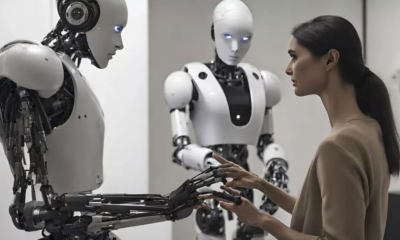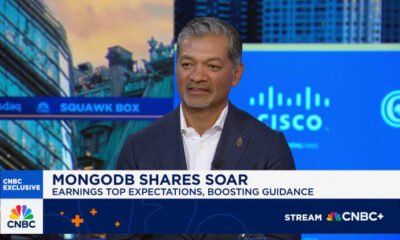Tools & Platforms
When Voices Lie: Understanding the Risks and Realities of Deepfake Voice Technology

Introduction
In today’s hyper-connected world, technology has become incredibly advanced—so much so that it’s now possible to replicate someone’s voice with chilling accuracy. What was once considered science fiction is now a reality, thanks to deepfake voice technology. Recently, I received a phone call from someone who sounded exactly like my boss. The voice had his same tone, mannerisms, and even the signature throat-clear he does before speaking. The caller asked me to send money to a vendor.
Fortunately, I double-checked with my boss, only to discover he had never called me. That disturbing moment opened my eyes to just how sophisticated deepfake voice technology has become. If you’re wondering how this is possible and what it means for your safety and privacy, read on.
What Is Deepfake Voice Technology?
Deepfake voice technology uses artificial intelligence, particularly machine learning and deep learning models, to replicate a person’s voice. The process involves feeding audio recordings of someone’s voice into an algorithm that analyzes and mimics their vocal patterns, pitch, intonation, and cadence.
The result is a synthetic voice that can be nearly indistinguishable from the original. This technology has evolved rapidly, with AI models now requiring only a few minutes—or even seconds—of audio to create a convincing imitation.
How Deepfake Voices Are Created
Creating a deepfake voice typically starts with gathering a voice dataset. This dataset is made up of audio clips, often taken from interviews, podcasts, or phone calls. The more diverse and lengthy the clips, the more accurate the AI-generated voice will be.
After collecting the data, deep learning models like GANs (Generative Adversarial Networks) or voice cloning algorithms process the information to synthesize a replica. These models learn the unique nuances of the speaker’s voice, enabling them to generate new sentences or even entire conversations in that voice.
Real-World Use Cases—Good and Bad
Like any technology, deepfake voice has both beneficial and malicious uses. On the positive side, this technology has been employed in film production, gaming, and even speech assistance for individuals who’ve lost their voices due to illness. Celebrities and public figures have also licensed their voices for AI-powered projects, such as virtual assistants or interactive media.
However, the darker side of deepfake voice is far more concerning. Scammers and cybercriminals are using it to commit fraud, impersonate executives, and manipulate people into transferring money or revealing sensitive information. As in the case mentioned earlier, a fake voice pretending to be a trusted authority figure can cause irreversible financial or reputational damage.
Why It’s So Convincing
What makes deepfake voice technology so alarming is how realistic it has become. Unlike traditional voice changers or impersonators, AI-generated voices capture subtle nuances, emotional tone, and natural rhythm.
Many people would struggle to tell the difference between a real voice and a deepfake over the phone. Moreover, since humans tend to trust familiar voices instinctively, the chances of deception increase significantly.
How to Protect Yourself from Deepfake Voice Scams
Awareness is your first line of defense. If you receive a suspicious call—even from someone you know—always verify the request through another communication channel. Call or message the person directly using a previously known number. Avoid taking action based solely on voice confirmation.
Organizations should also educate employees about the risks and implement multi-step verification for sensitive requests. Some cybersecurity solutions are now being developed to detect audio anomalies that may indicate a deepfake, though these are still in their early stages.
The Future of Voice Authentication
Voice recognition is widely used as a biometric authentication tool. However, the rise of deepfake voice technology calls its reliability into question. As threats evolve, so must our defenses.
Security experts are now pushing for multi-factor authentication systems that combine voice with facial recognition, passwords, or biometrics like fingerprints to ensure more secure access. Meanwhile, ongoing research is focused on creating tools that can detect AI-generated audio, just as tools now exist to detect image and video deepfakes.
Bottom Line
The story of the fake call that mimicked my boss’s voice was more than just a wake-up call—it was a glimpse into the power and potential danger of deepfake voice technology. While the innovation behind it is impressive, the risks it poses to personal privacy, financial security, and organizational trust are significant.
As this technology continues to develop, staying informed and cautious is crucial. By recognizing the signs and using verification steps, we can protect ourselves and our communities from the deceptive voices of tomorrow.
Tools & Platforms
iShares Future AI & Tech ETF (NYSEARCA:ARTY) Surges 27.6% in 2025 — Is It a Buy?

ARTY delivers strong tech exposure with 83% allocation to AI leaders, but volatility and valuations test investor conviction | That’s TradingNEWS
8/30/2025 8:54:36 PM
Tools & Platforms
Emperor Musk’s AI Clothes – Will Lockett’s Newsletter

Musk has been parading around in his AI clothes for a while now. With the amount he screams and shouts about AI, you’d think he invented it. Of course, like everything else Musk peddles, he had nothing to do with its invention or development, except for underpaying and overworking his engineers and being an awful, overpromising PR man. However, people aren’t just noticing that Musk’s clothes are non-existent — they are also starting to point and laugh at his skid marks and the “I Love the Nazi Man” tattoo down his back. Why? Because he just can’t seem to get his AI up and working. And there is no little blue pill to remedy this situation.
Take, for example, Tesla’s hilariously crap Robotaxi rollout. The media at large is only just cottoning on to it being a huge PR stunt.
I have gone on ad nauseam about why Tesla’s self-driving cars are completely inadequate, so if you want to know the details, read my previous article here. But the helicopter view is that, unlike other autonomous vehicles, Tesla’s system has zero redundancy or safety nets and requires a nearly 100% accurate AI — which categorically can’t exist — to be even remotely safe.
Tesla is painfully aware of this fatal flaw, with Tesla engineers whistleblowing their concerns about it to the media (read more here) and the DOJ opening an investigation (read more here). So I, along with countless other commentators, was pretty damn relieved to find out that Tesla’s Robotaxis had safety drivers. There was even mention of remote workers being able to take control of the car and drive it safely in the case of a critical disengagement.
But this kind of system isn’t impressive enough for Musk. Any Uber or Lyft driver with a Tesla who wastes their money on FSD can do the exact same thing. There is no social or investor kudos to be gained for Tesla or Musk here. And here is a hint: Musk doesn’t make money from Tesla sales. After all, his $50 billion pay packet (which is now less, thanks to Musk tanking Tesla’s valuation) was the equivalent of him getting $10,000 for every Tesla ever sold! Tesla makes substantially less profit from every car sold than that.
So, what do you do if you have bet your entire company’s valuation on autonomous technology that you simply can’t deliver on?
Fudge it.
Tesla put the safety driver in the passenger seat! Because, look, it’s a self-driving car — there is no one in the driver’s seat!
This is a dangerous move that offers no benefit other than optics.
Rather than being able to properly take over the car and drive it to safety, the only thing these safety drivers could do was press a button to bring the vehicle to a stop. Which, as anyone with a driving licence will tell you, is not always the safest option! Particularly when you consider that Robotaxis have been spotted driving into lanes of oncoming traffic.
Yet, this bafflingly shite decision wasn’t really reported on. Or at least it wasn’t until a video surfaced a few days ago that showed FSD failing and a safety driver being forced to exit the vehicle in the middle of traffic to take the driver’s seat and regain control. (watch it here).
This shows just how wildly dangerous Tesla’s Robotaxis are.
The safety driver had to take a serious risk to take control of the car. Not only that, but this incident suggests there are no remote operatives capable of taking over when things go wrong. That has been a core safety feature of all developing self-driving ride-hailing services, such as Waymo and Cruise, since day one and is routinely used to keep passengers safe. The fact that this is absent for Robotaxis, which Tesla already know have a far, far higher critical disengagement rate than any other self-driving ride-hailing service, could easily be seen as insanely negligent.
Musk is comfortable putting other people — not just the safety driver, but paying passengers and the public — in danger, all for a crappy PR stunt to cover up how bad his self-driving system actually is. And the media at large, as well as public consensus, are beginning to catch up to this horrifying fact.
However, Musk’s AI woes go far, far deeper than that.
Tools & Platforms
‘AI shame’ is a real phenomenon in the workplace, claims report; what may be ‘scaring’ top execs in America

A new survey from WalkMe, an SAP company, reveals a striking paradox in the modern workplace: The employees who use AI the most—top executives and Gen Z workers—are also the least likely to receive official guidance, training, or company approval for their use. The findings from the 2025 AI in the Workplace survey suggest that a phenomenon dubbed “AI shame” is taking hold. The annual survey polled 1,000 working U.S. adults who use AI in their jobs to understand the reality of AI adoption. Nearly half of all workers surveyed (48.8%) admitted to hiding their use of AI on the job to avoid judgment. This discomfort is particularly pronounced at the top, with 53.4% of C-suite leaders confessing they conceal their AI habits, despite being the most frequent users.x`Almost half (45%) of workers admit to pretending to know how to use an AI tool in a meeting to avoid scrutiny, while 49% have hidden their use of AI to avoid judgment. This trend is even more pronounced among Gen Z, with 55.5% pretending to understand AI tools and 62% hiding their use.
What makes Gen Z anxious about AI
Gen Z workers show both enthusiasm and anxiety regarding AI. A notable 62.6% of Gen Zers have used AI to complete work but then pretended it was their own, the highest rate among any generation. Over half (55.4%) have feigned understanding of AI in meetings.Despite this widespread use—89.2% of Gen Z employees use AI at work — they report receiving the least amount of support. Only 6.8% have received extensive, time-consuming AI training, and 13.5% received none at all. This lack of formal guidance has led 89.2% of them to use tools not provided or sanctioned by their employers.“Companies are not educating enough about this whole thing,” said Sharon Bernstein, WalkMe’s Chief Human Resources Officer, in an interview with Fortune. She noted that companies are failing to facilitate the use of AI tools or guide their employees effectively.
AI ‘Class Divide’ and Productivity Dilemma
The survey also points to an “AI class divide,” where access to training and guidance increases with rank. Only 3.7% of entry-level employees receive substantial training, compared to 17.1% of C-level executives. This leaves the most frequent users, junior and younger staff, to navigate the new technology on their own, risking a growing knowledge gap.While 80% of employees believe AI has boosted their productivity, a significant number are struggling. Almost 60% confessed to spending more time trying to manage AI tools than it would have taken to do the work themselves.Gen Z is particularly affected by this paradox:* 65.3% say AI slows them down, the highest among all age groups.* 68% feel pressure to produce more work because of it.* Nearly one in three are deeply anxious about AI’s impact on their jobs.This disconnect between corporate hype and on-the-ground reality fits into a broader picture of chaotic AI implementation. For instance, a recent MIT study found a staggering 95% failure rate for generative AI pilot programs at large enterprises, suggesting a significant gap between the theory of AI and its practical application.
-
Tools & Platforms3 weeks ago
Building Trust in Military AI Starts with Opening the Black Box – War on the Rocks
-

 Ethics & Policy1 month ago
Ethics & Policy1 month agoSDAIA Supports Saudi Arabia’s Leadership in Shaping Global AI Ethics, Policy, and Research – وكالة الأنباء السعودية
-

 Events & Conferences3 months ago
Events & Conferences3 months agoJourney to 1000 models: Scaling Instagram’s recommendation system
-

 Jobs & Careers2 months ago
Jobs & Careers2 months agoMumbai-based Perplexity Alternative Has 60k+ Users Without Funding
-

 Funding & Business2 months ago
Funding & Business2 months agoKayak and Expedia race to build AI travel agents that turn social posts into itineraries
-

 Education2 months ago
Education2 months agoVEX Robotics launches AI-powered classroom robotics system
-

 Business1 day ago
Business1 day agoThe Guardian view on Trump and the Fed: independence is no substitute for accountability | Editorial
-

 Podcasts & Talks2 months ago
Podcasts & Talks2 months agoHappy 4th of July! 🎆 Made with Veo 3 in Gemini
-

 Podcasts & Talks2 months ago
Podcasts & Talks2 months agoOpenAI 🤝 @teamganassi
-

 Mergers & Acquisitions2 months ago
Mergers & Acquisitions2 months agoDonald Trump suggests US government review subsidies to Elon Musk’s companies





















